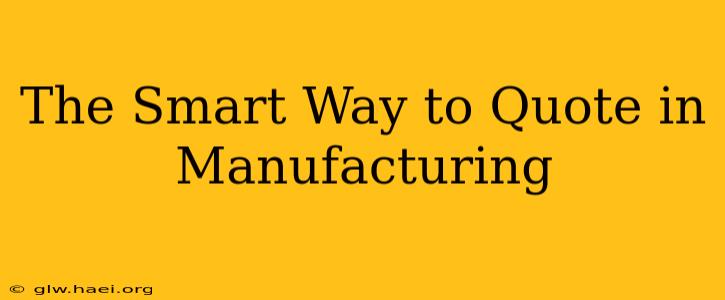The manufacturing world thrives on precision. Every bolt, every weld, every carefully calibrated process contributes to the final product. But before any of that happens, there's a crucial first step that determines success or failure: quoting. Getting your quotes right isn't just about securing jobs; it's about securing profitable jobs. This isn't a game of luck; it's a strategic process that requires careful planning, meticulous attention to detail, and a deep understanding of your costs. Let's dive into the smart way to quote in manufacturing, transforming your quoting process from a potential pitfall into a powerful engine for growth.
Understanding Your Costs: The Foundation of Accurate Quoting
Before you even think about putting pen to paper (or fingers to keyboard), you need an ironclad grasp of your costs. This isn't just about adding up raw materials; it's about a comprehensive understanding of your entire cost structure. Think of it like this: you're building a house; you need to know the cost of the lumber, the bricks, the labor, the permits, and even the unexpected repairs. The same applies to manufacturing.
What are the different types of manufacturing costs?
This involves breaking down your costs into several key categories:
- Direct Materials: The raw materials directly used in the production process. This is the easiest to calculate, but you need to account for waste and potential price fluctuations.
- Direct Labor: The wages and benefits paid to employees directly involved in production. Accurate time tracking is crucial here.
- Manufacturing Overhead: This is the less obvious but equally critical element. It encompasses all indirect costs related to production, including rent, utilities, machinery maintenance, and depreciation. Often, this is where less experienced manufacturers make mistakes, underestimating the true cost.
Ignoring any of these aspects can lead to drastically underquoted projects, eating into your profits and potentially damaging your reputation. A detailed cost accounting system is your best friend.
Mastering the Art of Accurate Estimation
Accurate estimation is the heart of smart quoting. It's not about guessing; it's about using data and experience to create realistic projections. This requires a multi-faceted approach:
- Detailed Bill of Materials (BOM): A comprehensive BOM lists every single component, material, and sub-assembly required for the project. Leaving something out can be disastrous.
- Process Mapping: Visualize your entire manufacturing process. This helps identify potential bottlenecks, which can significantly impact production time and cost.
- Time Studies: Regularly conduct time studies to accurately determine the labor required for each task. This helps refine your estimations over time and avoid overestimating or underestimating labor costs.
By meticulously analyzing your processes, you can move away from guesswork and build a strong foundation for accurate estimates.
How can I improve my quoting accuracy?
Regularly review past projects, comparing actual costs to your initial estimates. Identify discrepancies and adjust your processes accordingly. Technology can play a vital role here, with software capable of automating many aspects of the quoting process and providing detailed analysis.
Beyond the Numbers: Understanding Client Needs and Building Relationships
Smart quoting isn't just about crunching numbers; it's about understanding your client's needs. Ask clarifying questions, actively listen, and ensure you're providing a solution tailored to their specific requirements. Building strong, trusting relationships with clients is invaluable – it often leads to repeat business and referrals.
How do I handle unexpected issues or changes during a project?
Establish clear communication protocols with clients from the start. Outline procedures for handling changes to the original scope of work, clearly defining the associated costs and timelines. Transparency and open communication are crucial here.
Pricing Strategies for Profitability
Once you have a solid grasp of your costs and client needs, you can develop a pricing strategy that ensures profitability. Consider different approaches:
- Cost-Plus Pricing: A straightforward method where you add a markup percentage to your total costs. This is simple but may not be competitive in highly price-sensitive markets.
- Value-Based Pricing: This approach focuses on the value you deliver to the client. It requires a thorough understanding of their needs and how your solution solves their problems.
- Competitive Pricing: This involves researching competitors' prices and adjusting your own accordingly. Be cautious not to undervalue your expertise and services.
Choosing the right pricing strategy depends on your market, your client base, and the complexity of your projects.
The Future of Manufacturing Quoting: Embracing Technology
Technology is transforming the manufacturing landscape, and quoting is no exception. Software solutions can automate many aspects of the process, streamlining workflows and reducing errors. These tools can provide real-time cost analysis, manage complex BOMs, and even integrate with ERP systems for seamless data flow. Embracing technology allows you to quote faster, more accurately, and more efficiently.
By incorporating these strategies, you're not just creating quotes; you're building a sustainable and profitable manufacturing business. The smart way to quote is a continuous process of learning, adapting, and optimizing. It's an investment in your future success.

